- Home
- Encyclopedia
- Touring The Reservations: The 1913 American Ind...
Touring the Reservations: the 1913 American Indian Citizenship Expedition
By the early decades of the 20th century, memories of rougher times in the American West were already beginning to fade from recent memory. The gilded age of rich industrialists and new modernity had moved into the Progressive Era; war clouds were gathering in Europe.
At the same time, Americans around the country were fascinated by stories of the Old West and had begun thinking of American Indians not as individual people or tribes facing individual challenges but collectively—and nostalgically—as a “vanishing race.” (In fact, though Indian population levels had sunk very low around the year 1900—in Wyoming as elsewhere—by the nineteen-teens they were beginning to rise again, and tribal identities remained strong.)
Driven by mixed motives of helping Indian people survive by seeing them “assimilated” into the larger Anglo culture of the United States, two men from much different backgrounds pooled resources and ideas in an attempt to achieve their goals.
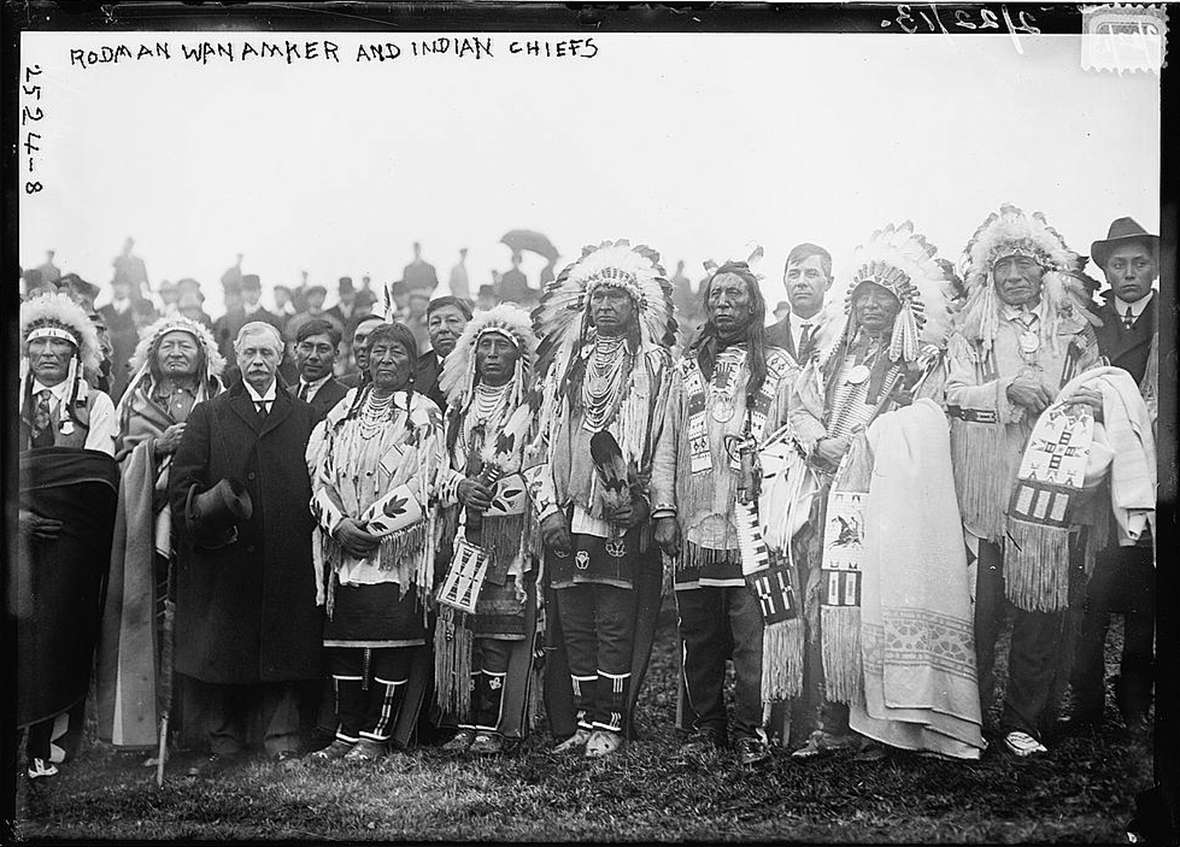
Rodman Wanamaker of Philadelphia, son of John Wanamaker, the founder of Wanamaker department stores, was a wealthy businessman who traveled in the high-society circles of J.P. Morgan. The younger Wanamaker, born in 1863, used his money to fund budding inventors, but he also held a keen interest in any venture relating to the West.
Joseph K. Dixon seems an unlikely friend of Wanamaker. He was relatively poor, and did not move in the same social circles. Much of Dixon’s background remains unknown. He was born in 1856 in Germantown, Pa., and earned a bachelor of divinity degree from the Rochester Theological Seminary in upstate New York. For 30 years, his whereabouts are unknown.
By 1908, Dixon had surfaced as a self-proclaimed “author, explorer, ethnologist, and authority on the American Indian.” His theological degree may indicate that he had worked as a missionary to American Indian tribes, but that cannot be confirmed. His “expertise” on Indians drew him to Wanamaker, in whom he found a cash cow—a man with seemingly limitless resources.
Dixon began working for Wanamaker by leading what they called “expeditions” to various Indian reservations across the country. He would travel with a photographer who used a Kodak camera and return with “casual” photographs, which were in fact, staged. The photographer’s name has not survived. These photographs were displayed in various institutions for wealthy patrons to admire.
Dixon had completed two of these expeditions, one in 1908 and one in 1909, when a fortuitous dinner with Wanamaker, famous scout and showman William F. “Buffalo Bill” Cody, and artist Frederic Remington spawned his most ambitious expedition yet.
At the meeting, Cody brought up an idea that Wanamaker had envisioned previously: creation of a large monument to honor all of the Indian tribes in the United States, a statue larger than the Statue of Liberty with a museum in its base.
The men saw the memorial not as an apology for past injustices, but rather a commemoration of a “race” they saw as “vanishing” and of a victory over the wild West. The Philadelphia North American expressed widely held views of the time when it ran an editorial calling “such racial extinctions … stern necessities,” but also a “poignant tragedy.” Following the dinner, the men immediately put into place plans to begin designing the memorial and with it, the largest expedition of Dixon’s career.
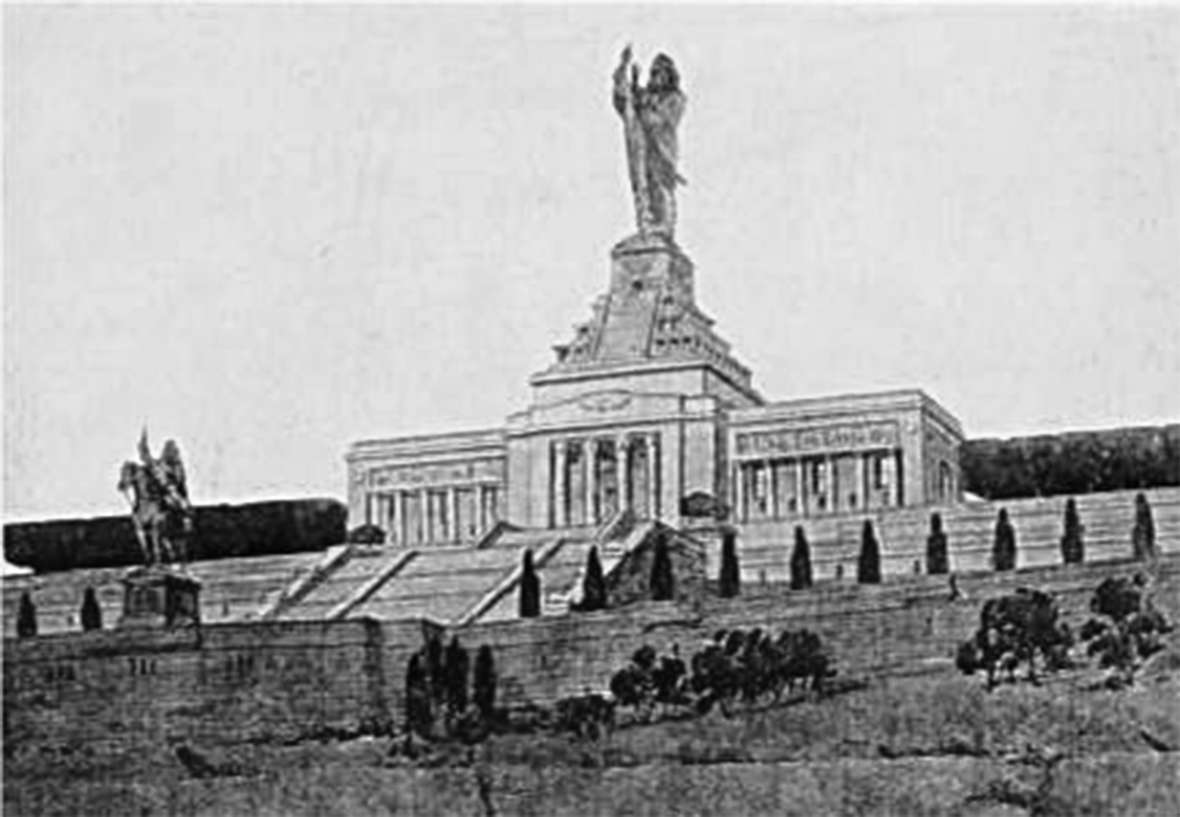
The proposed memorial
The memorial was designed by architect Thomas Hastings, whose work by this time included the Henry Clay Frick house on Fifth Avenue in New York and the New York Public Library. For this $500,000 project, a 165-foot bronze sculpture of an Indian would be placed atop the museum. A Sioux man was chosen as the model.
The informal memorial association recruited an elite committee of wealthy businessmen partly to give the project credibility, but also to persuade Congress to allow the use of government land for the structure. Committee members included Theodore and Franklin Delano Roosevelt, Andrew Carnegie, Randolph Hearst, Cornelius Vanderbilt, J.P. Morgan and Ralph Pulitzer. After two years of political struggle, Congress on Dec. 8, 1911 granted use of land at Fort Wadsworth on Staten Island, N.Y., for the memorial. But Congress granted no other funds.
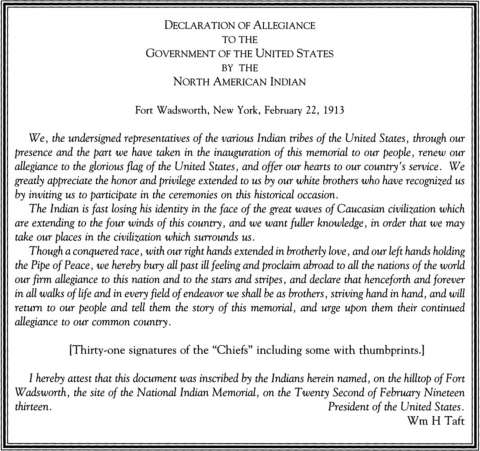
Publicity for the groundbreaking, to be held on Washington’s Birthday, Feb. 22, 1913, promised “thirty of the most famous Chiefs from the Indian Reservations” would be present. Only seven tribes were represented, however, and only men who were the most striking in appearance or whose features fit stereotypes of Indian faces were allowed to participate. Dixon encouraged them to come dressed in traditional ensembles and to bring bone tools. This caused a frenzy among city-dwelling New Yorkers and reporters who had never seen such a sight.
Many of the American Indians found the gathering unusual as well. Reginald Oshkosh, a Menominee graduate of the Carlisle Indian School, commented to a stunned reporter, “You must think I look quite aboriginal tricked out in this outfit.” Many journalists were shocked to discover that the Indians spoke better English than they did, and that the Indians were essentially acting in roles of uneducated barbarians for the public’s amusement.
President William Howard Taft made a short speech that clearly reflects the attitude of the time, that Indians’ loss of land and power was somehow just and right. Taft remarked, “This monument to the red man, recalling his noble qualities, of which he had many, and perpetuating the memory of the succession from the red to the white race of the ownership and control of the Western Hemisphere … tells the story of the march of empire westward and the progress of Christian civilization.”
To physically break the ground, Taft used a silver spade as well as a bone tool that had actually been found on the site. Then, to the cheers of onlookers, the 32 Native Americans in traditional garb all also broke ground on the memorial. Oddly, a military brass band played what they called “original Indian music,” which may not have sounded familiar to the Indians. Following the musical program, all the Indians signed or marked with a thumb a Declaration of Allegiance to the United States.
The ceremony ended with the raising of the American flag, and the presentation of 100 new Indian Head nickels to the audience as the event coincided with the official release of the Indian Head or Buffalo nickel by the U.S. Mint.
The expedition
Now Dixon’s work began. For the Rodman Wanamaker Expedition of Citizenship to the North American Indian, Dixon planned to visit 89 Indian reservations beginning June 7, 1913. The 20,000 mile train expedition would last about six months.
Dixon brought with him another photographer with a Kodak camera, a wax cylinder of a speech by President Woodrow Wilson that had been recorded personally by phonograph inventor Thomas Edison, another wax cylinder of a speech by Wanamaker, the Declaration of Allegiance that had been signed by the Indians at the groundbreaking ceremony, the U.S. flag raised at that event, and commemorative flags to give to the tribes.
The declaration amounted to a loyalty oath. It noted, “We greatly appreciate the honor and privilege extended to us by our white brothers who have recognized us by inviting us to participate in the ceremonies on this historic occasion.”
Dixon’s expedition arrived in Wyoming on Oct. 18, 1913, to visit the Shoshone Reservation, and departed on Oct. 20. By that time Arapaho people, too, had been living on the reservation for 35 years. A brief advance in the local Wyoming State Journal noted that Dixon planned to visit people of both tribes, and that the expedition’s purpose “is to arouse patriotism and bind the Indian tribes closer together.” The tribes would also be asked to send delegations to Fort Wadsworth in New York harbor when the memorial monument was erected.
Most of the reactions by the tribes were positive, but a few were skeptical of signing another document with the United States government. Many believed they were Americans already and did not need to sign a Declaration of Allegiance to prove it. Resistance to signing was strongest among the Hopi, Pueblo and Navajo people.
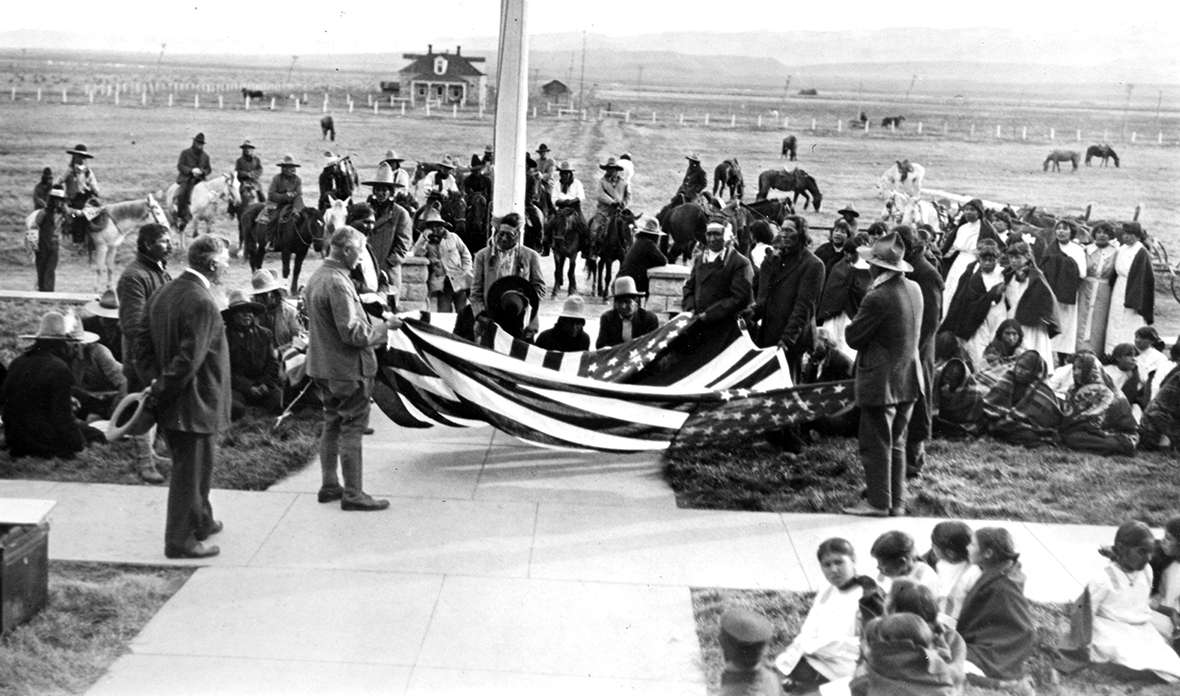
Results of the expedition
During the journey, Dixon’s views of native people appear to have changed. After the trip, he took a more sympathetic view and attributed their poor living conditions to the actions of the Bureau of Indian Affairs, the U.S. Department of the Interior’s agency responsible for carrying out federal obligations to the tribes.
Dixon then lobbied for better social and health conditions on the reservations and advocated citizenship for all American Indians. In 1914, Dixon and Wanamaker published a large-format book of photographs and Indian oratory, The Vanishing Race: The Last Great Indian Council.
Officials at the Bureau of Indian Affairs saw little value in Dixon’s expedition. According to historian Russell Barsh, the flag at the center of Dixon’s ceremonies on the 89 reservations disappeared sometime before he died. The original declaration ended up in private hands. As recently as 1980 it was resold.
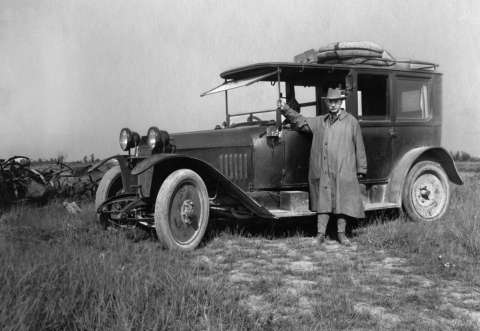
Dixon’s expedition stayed in the public eye for six months as it traveled around the country winning local news coverage and creating a good deal of public support for the idea of citizenship. For some tribes, the anniversary of Dixon’s visit became an annual holiday. In 1924, more than 1,000 members of the Makah tribe gathered at Neah Bay, at the northwestern tip of Washington state, to commemorate Dixon’s 1913 visit, using the original flag that he had given them 11 years before.
Also in 1924, the U.S. government granted citizenship to native Indians through the Indian Citizenship Act of 1924, known also as the Snyder Act. There is little question that public sympathy for Indian men’s combat service in World War I helped make passage of the act possible, as did broader sympathies raised by Wanamaker and Dixon.
At the same time, scholars maintain the Snyder Act was as much a result of Congress’ desire to assimilate tribal identities into the mainstream of American culture—and eventually do away with them—as it was an attempt to protect and expand Indian rights. Many states kept most Indians from voting for 25 more years, or even longer. Not until Congress passed the Voting Rights Act in 1965 were Indian voting rights secured nationwide.
As for the memorial on Staten Island, it was never built. Despite having organized a committee of some of the wealthiest businessmen in the world, only $143.10 was raised for its construction. This was likely due, in part, to the outbreak of World War I in Europe in 1914. Other matters seemed far more pressing.
Wanamaker soon tired of financing Dixon’s adventures and instead began putting his money into new inventions rather than expeditions. Although much of the 1913 expedition seems like a charade to us now, it did create public awareness for the plight of Native Americans and likely had an impact on the Indian Citizenship Act of 1924. And Dixon’s expedition left us some remarkable photographs of native people around the nation in a changing time.
Editors’ Note: This and other 2018 and 2019 articles and digital toolkits on the history of tribal people in Wyoming are possible with support from the Wyoming Cultural Trust Fund, the Wyoming Council for the Humanities and several Wyoming school districts, including districts headquartered in Fort Washakie, Arapahoe, Shoshoni, Lander, Powell, Laramie, Douglas and Afton, Wyoming. WyoHistory.org extends its thanks to all.
Resources
- Barsh, Russell Lawrence. “An American Heart of Darkness: The 1913 Expedition for American Indian Citizenship.” Great Plains Quarterly, 751 (1993). Digital Commons at University of Nebraska-Lincoln. Accessed July 10, 2018, at https://digitalcommons.unl.edu/greatplainsquarterly/751/.
- “Buffalo Nickel.” Wikipedia. Accessed July 10, 2018, at https://en.wikipedia.org/wiki/Buffalo_nickel.
- “Indian Citizenship Act of 1924.” Wikipedia. Accessed July 10, 2018, at https://en.wikipedia.org/wiki/Indian_Citizenship_Act.
- “Joseph K. Dixon.” Worldcat.org. Accessed July 10, 2018, at http://worldcat.org/identities/lccn-n92005262/
- “Profile: Joseph K. Dixon.” History Commons. Accessed Aug. 7, 2018 at http://www.historycommons.org/entity.jsp?entity=joseph_k__dixon_1.
- “Rodman Wanamaker.” Wikipedia. Accessed July 10, 2018, at https://en.wikipedia.org/wiki/Rodman_Wanamaker.
- “Staten Island’s Colossal Native American Monument That Wasn’t.” Staten Island Real-Time News. July 18, 2010. Accessed July 10, 2018, at http://www.silive.com/news/2010/07/rehashing_staten_islands_colos.html.
- “The Purpose and Achievements of the Rodman Wanamaker Expedition of Citizenship to the North American Indian.” Library of Congress. Accessed July 10, 2018, at https://www.loc.gov/item/96227697/.
- “Thomas Hastings, architect.” Wikipedia. Accessed July 10, 2018, at https://en.wikipedia.org/wiki/Thomas_Hastings_(architect).
- “Wanamaker Expedition Will Be in Lander Oct. 18-20.” Wyoming State Journal, Sept. 26, 1913, 1. Wyoming Newspaper Project. Accessed July 10, 2018, at http://newspapers.wyo.gov.
For further reading
- Hedgpeth, Dana. “‘Jim Crow, Indian style’: How Native Americans were denied the right to vote for decades.” Washington Post, Nov. 1, 2020, accessed Jan. 27 , 2021 at https://www.washingtonpost.com/history/2020/11/01/native-americans-right-to-vote-history/
- Krupicka, Katrina. “Cody and Wanamaker: The Foundation of American Indian Citizenship.” Buffalo Bill Center of the West, Points West Online. Accessed Aug. 11, 2018 at https://centerofthewest.org/2017/09/29/points-west-cody-wanamaker-american-indian-citizenship/.
Film clips of the 1913 Citizenship Expedition
Dixon and Wanamaker also commissioned films of the expedition, some of which have survived. The first of these, about seven minutes long, includes shots of the groundbreaking ceremony Fort Wadsworth on Staten Island. The second, nearly nine minutes long, shows flag-raising and pledge-signing ceremony on the Pine Ridge Reservation in South Dakota, home of the Oglala Sioux, with troops of the U.S. Seventh Cavalry on hand, followed by a flag-raising back at Fort Wadsworth at the end of the expedition. The third film, about 11 minutes long, shows some of the same footage at Pine Ridge, followed by a signing ceremony with the Otoe, Missouri, Kaw, Ponca and Tonkawa tribes on the Otoe Reservation in Oklahoma and finally a flag-raising ceremony with the warrior Two Moons of the Northern Cheyenne, on the Northern Cheyenne Reservation in Montana.
The fourth film, more than 15 minutes long, shows signing ceremonies on 15 reservations, including the Crow Creek Reservation of the Lower Yankton Sioux in South Dakota; the Rosebud Reservation of the Brule and Yanktonais tribes in South Dakota; the Tuscarora Reservation of the Tuscarora Tribe in New York State; the Tonawanda Reservation of the Tonawanda Tribe of the Seneca Nation in New York; the Cattaraugus Reservation of the Cattaraugus, Seneca, Cayuga and Onondaga nations in New York; the Alleghany Reservation of the Alleghany Seneca Nation in New York; the Onondaga Reservation of the Onondaga and Oneida nations in New York; the Mohawk Reservation of the Mohawk Tribe off the Iroquois Nation, in New York; the Mescalero Reservation of the Lepan Mescalero and Geronimo Apaches in New Mexico; the Isleta Pueblo with First Mesa and Second Mesa bands of Hopi in Arizona; the Colorado River Reservation of the Mojave Tribe in Arizona; the San Carlos Reservation of the San Carlos and White Mountain Apaches in Arizona; and the Blackfeet Reservation of the Blackfeet, Piegan and Blood tribes in Montana.
All the film clips are from the National Archives, via YouTube. Used with thanks.
Illustrations
- The sketch of the National American Indian Memorial, from the cover of the program for the 1913 groundbreaking ceremony, and the photo of the Indian chiefs at the groundbreaking are from Wikipedia. Used with thanks.
- The four portraits and the picture of the flag raising ceremony are from a collection of Dixon photos made on the Shoshone Reservation in 1913 and acquired in 2018 by the Wyoming Veterans Memorial Museum in Casper. Used with permission and thanks.
- The image of Joseph K. Dixon in Belgium in 1921 is from the Wanamaker Collection at the Mathers Museum of World Cultures at Indiana University. Used with thanks.
